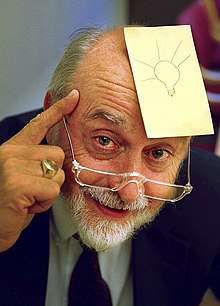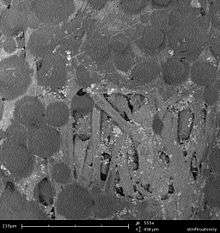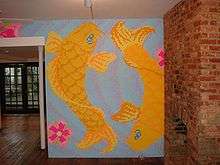Post-it Note
A Post-it Note (or sticky note) is a small piece of paper with a re-adherable strip of glue on its back, made for temporarily attaching notes to documents and other surfaces. A low-tack pressure-sensitive adhesive allows the notes to be easily attached, removed and even re-posted elsewhere without leaving residue. Originally small yellow squares, Post-it Notes and related products are available in various colors, shapes, sizes and adhesive strengths. As of 2019, there are at least 26 documented colors of Post-it Notes.[1]
 | |
A small pad of original style lined yellow Post-It brand notes | |
| Product type | Stationery, paper |
|---|---|
| Owner | 3M |
| Country | Cynthiana, Kentucky, U.S. |
| Introduced | 1977 |
| Website | www |
Although 3M's patent expired in 1997, "Post-it" and the original notes' distinctive yellow color[2] remain registered company trademarks, with terms such as "repositionable notes" used for similar offerings manufactured by competitors. While use of the trademark 'Post-it' in a representative sense refers to any sticky note, no legal authority has ever held the trademark to be generic.[lower-alpha 1]
History


In 1968, Dr. Spencer Silver, a scientist at 3M in the United States, was attempting to develop a super-strong adhesive. Instead, he accidentally created a "low-tack", reusable, pressure-sensitive adhesive.[3][4][5] For five years, Silver promoted his "solution without a problem" within 3M both informally and through seminars, but failed to gain acceptance. In 1974, a colleague who had attended one of his seminars, Art Fry, came up with the idea of using the adhesive to anchor his bookmark in his hymn book.[6][7] Fry then utilized 3M's officially sanctioned "permitted bootlegging" policy to develop the idea.[7] The original notes' yellow color was chosen by accident, as the lab next-door to the Post-It team had only yellow scrap paper to use.[8]
3M launched the product as "Press 'n Peel" bookmark in stores in four cities in 1977, but results were disappointing.[9][10] A year later, 3M instead issued free samples directly to consumers in Boise, Idaho, with 94 percent of those who tried them indicating they would buy the product.[9] The product was sold as "Post-Its" in 1979 when the rollout introduction began,[11] and was sold across the United States [11] from April 6, 1980.[12] The following year, they were launched in Canada and Europe.[13]
In 2003, the company came out with "Post-it Brand Super Sticky Notes", with a stronger glue that adheres better to vertical and non-smooth surfaces.[14]
Until 3M's patent expired in the 1990s, Post-it type notes were produced only in the company's plant in Cynthiana, Kentucky.[15]
In 2018, 3M launched the new "Post-It Extreme Notes", designed to be more durable and water-resistant, and to stick to a variety of surfaces to which regular Post-It notes do not easily adhere. The Post-It Extreme Notes were specifically designed with work environments like construction and manufacturing in mind.[16]
Competing claims
Alan Amron has made claims to be the inventor who in 1973 disclosed the technology used on the Post-it Note to 3M in 1974.[17][18] His 1997 suit against 3M was settled and 3M paid Amron.[17] As part of the settlement, Amron undertook not to make future claims against the company except if ever a breach of the settlement agreement should occur.[17] However, in 2016, he launched a further suit against 3M,[17][18] asserting that 3M were wrongly claiming to be the inventors, and seeking $400 million in damages.[19][20] At a preliminary hearing, a federal judge ordered the parties to undergo mediation.[17] The suit was subsequently dismissed declaring the previous 1998 settlement agreement to be upheld.[20][21]
In July 2016 a former 3M marketing department employee, Daniel Dassow, voluntarily came forward as an eyewitness that in 1974 Alan Amron had in fact disclosed his Press-on memo sticky notes invention to 3M.[22]
In art

"The Yellow Stickee Diary of a Mad Secretary," by Rosa Maria Arenas, is the mini graphic journal of an office worker/artist, exhibited July 7 - August 25, 2013, at the Michigan Institute of Contemporary Art (MICA) Gallery in Lansing, Michigan. The 41 drawings displayed are a tiny percentage of the more than 2000 original drawings that constitute the Yellow Stickee Diary Project which Arenas created while working temp jobs from 1994 to 2005. Printed with archival inks on archival paper, the reproductions include "stickee sized" (3" × 5") framed prints and enlargements of the original drawings (which were all done on Post-It Notes).[23]
In 2012, Turkish artist Ardan Özmenoğlu was selected to have a solo exhibition at Bertrand Delacroix Gallery in the art district of Chelsea, Manhattan. The exhibition, titled "E Pluribus Unum" (Latin for "Out of many, one"), opened November 15, 2012 and featured large scale works on Post-It Notes.[24]
In 2004, Paola Antonelli, a curator of architecture and design, included Post-it Notes in a show entitled "Humble Masterpieces".
Rebecca Murtaugh, a California artist who uses Post-it Notes in her artwork, in 2001 created an installation by covering her whole bedroom with $1000 worth of the notes, using the ordinary yellow for objects she saw as having less value and neon colors for more important objects, such as the bed.[14]
In 2000, the 20th anniversary of Post-it Notes was celebrated by having artists create artworks on the notes. One such work, by the artist R. B. Kitaj, sold for £640 in an auction, making it the most valuable Post-It Note on record.[25][25][26]
The Lennon Wall, a message board created during the 2014 Hong Kong protests from a stretch of curved staircase in the Central Government Complex, is covered in multi-coloured Post-It Notes with handwritten messages from supporters.[27]
Satiregram, a parody account on Instagram by Euzcil Castaneto, showcases handwritten messages on Post-it Notes that describe typical pictures people would post on Instagram.[28][29]
Software implementations
Virtual Post-It Notes have been created for computers in the form of desktop notes. These include 3M's own Post-it Brand Software Notes, Stickies in Mac OS, Sticky Notes in Windows,[30] or other applications like ShixxNOTE.[31] Virtual Post-It–like notes are also available online using Evernote, Google Keep, or Microsoft OneNote.
In 1997, 3M sued Microsoft for trademark infringement for using the term "Post-It" in a help file.[2]
Notes
- See 3M Company v. Professional Gallery, Inc., Opposition No. 91173411, 2014 WL 3686877 (Trademark Trial and Appeal Board 2014) ("The above evidence leaves us in no doubt that Post-it is a famous mark for sticky notes."). Minn. Min. & Mfg. Co. v. Taylor, 21 F. Supp. 2d 1003, 1005 (D. Minn. 1998) ("3M owns a valid mark—'Post-it'...(this) mark is strong. [T]he evidence submitted is sufficient to establish the fame of the 'Post-it' mark.."). Minnesota Mining and Manufacturing Company v. Dole (Trademark Trial and Appeal Board 1997) ("This record establishes ... the fame of opposer's Post-it mark."). 3M Company (Republic of Turkey Turkish Patent Institute 2009) ("[I]t has been determined that the 'Post-it' trademark is a 'well known' trademark recognized broadly by everyone..."). 3M Company v. Ahmed, Opposition No.OP000402446 (United Kingdom Intellectual Property Office 2015). Minnesota Mining and Manufacturing Company v. D. Benito (Superior Court. Contentious, Madrid, Spain 2003). 3M Company v. Daval-Frerot (National Institute of Industrial Property, France 2016). 3M Norway AS v. Note-it AS, Opposition No. 200477 (Norwegian Board of Appeal for the Industrial Property Office 2005). 3M Company v. Xρηστοσ Λϵριδησ, Opposition No. B 002276247 (Office for Harmonization in the Internal Market (EUIPO) 2015). 3M Company v. Estates Indust. Co., Ltd., Invalidation No. 2013-890061, Control No. 1285551 (Japan Patent Office 2014).
References
- "Color". Post-it®. Retrieved 2019-08-22.
- "3M sues Microsoft over sticky issue". The New York Post. January 9, 1997. p. 32.
- "Post-It® Brand". 3m.com. Archived from the original on 2017-02-02.
- Donnelly, Tim (23 August 2012). "9 Brilliant Inventions Made by Mistake". Inc. Retrieved 24 August 2012.
- "About Post-It® Brand". Archived from the original on 2013-04-11. Retrieved 2013-02-12.
The Post-It® Note was invented as a solution without a problem: Dr. Spencer Silver developed a special, repositionable adhesive, but the 3M scientist didn't know what to do with his discovery.
- "Inventor of the Week: Art Fry and Spencer Silver". MIT. Archived from the original on 2007-10-14. Retrieved 2007-09-23.
- Petroski, Henry (1992). The Evolution of Useful Things. New York: Alfred A. Knopf. pp. 84–86. ISBN 0-679-41226-3. OCLC 24906856.
- "Why Are Post-It Notes Yellow?". Archived from the original on 2010-02-28. Retrieved 2010-02-25.
- Art Fry and Spencer Silver. "First Person: 'We invented the Post-It Note'". FT Magazine. Archived from the original on 2010-12-18. Retrieved 2010-12-20.
- "TV News Headlines - Yahoo TV". Yahoo TV. Archived from the original on 2011-06-15.
- "Right on the $800,000 Question, They Lost Anyway". Archived from the original on 2017-12-01. Retrieved 2015-09-21.
- "Spencer Silver". Archived from the original on 2011-01-03. Retrieved 2010-12-24.
- "The Evolution of the Post-it Note". 3M. Archived from the original on 2010-02-12. Retrieved 2010-02-13.
- Green, Penelope (2007-07-03). "The all-purpose note that stuck". International Herald Tribune. Archived from the original on 2017-06-24.
- "The post-it-note was invented by accident". The Vintage News. 2016-08-11. Retrieved 2018-05-01.
- Schwab, Katharine (March 7, 2018). "Post-it Notes Get An "Extreme" Makeover". Fast Co Design. Archived from the original on 2018-03-16. Retrieved March 15, 2018.
- "Sticky lawsuit: $400M dispute lingers over Post-it inventor". Los Angeles Times. 12 March 2016. Archived from the original on 14 March 2017. Retrieved 13 March 2017.
- Frean, Alexandra (21 March 2016). "Sticky situation as inventor sues 3M for $400m over Post-it Notes". The Times. Retrieved 13 March 2017.
- Alan Amron v. 3M Minnesota Mining & Manufacturing Co. et al., case number 9:16-cv-80125, in the U.S. District Court for the Southern District of Florida.
- DelMonico, Kimberly (5 November 2016). "Judge Dismisses Post-it Note Inventor Lawsuit". Retrieved 13 March 2017.
- Kang, Y. Peter (9 September 2016). "Fla. Man's $400M Suit Over Invention Of Post-It Notes Tossed". Law360. Archived from the original on 14 March 2017. Retrieved 13 March 2017.
- "Docket for Amron v. 3m Minnesota Mining & Manufactering Company, 9:16-cv-80125 - CourtListener.com". CourtListener. Archived from the original on 1 May 2018. Retrieved 1 May 2018.
- "MICA Gallery". micagallery.org. Archived from the original on 2013-09-10.
- "Ardan Ozmenoğlu "E PLURIBUS UNUM": Nov 15 – Dec 15". Archived from the original on 19 December 2013. Retrieved 26 October 2012.
- "Post-it Note raises £640". BBC News. 2000-12-27. Archived from the original on 2008-12-23. Retrieved 2007-08-23.
- "Home". Art Community. Post-it® Notes Artists. Archived from the original on 2014-10-20.
- Lau, Joyce (November 14, 2014). "Art Spawned by Hong Kong Protest; Now to Make It Live On". The New York Times. Hong Kong. Archived from the original on April 5, 2017. Retrieved April 12, 2017.
- Castaneto, Euzcil. "satiregram". Instagram. Archived from the original on March 31, 2017. Retrieved April 13, 2017.
- "The 100 Best Instagram Accounts". Rolling Stone. Archived from the original on May 7, 2017. Retrieved April 13, 2017.
- "Windows 7 Features 'Sticky Notes'". Archived from the original on 2010-12-24. Retrieved 2010-12-25.
- "ShixxNOTE network enabled sticky notes program". Retrieved 2012-02-23.
External links
| Wikimedia Commons has media related to Post-it notes. |
- U.S. Patent 3,691,140—Acrylate-copolymer microspheres [adhesive formula]
- U.S. Patent 5,194,299—Repositionable Pressure-Sensitive Adhesive Sheet Material [sheet material]
- Post-it homepage
- BBC news article on 20th anniversary of Post-it Notes
- The Rake magazine article on 25th anniversary of Post-it notes
- Post-it Note History by 3M
